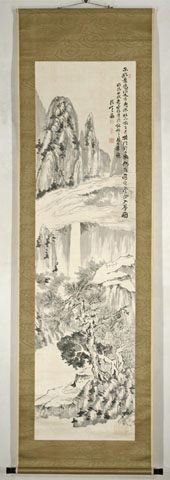Nanga
LandscapeSigned: Oite Tadasu* ki tsuki kore zai saryô Shinten'ô Tadasu no mori
Seals: Yamanaka ken in. Shinten’ô, Tannyo (top) & Waga kokora ishi ni arazu
Technique: sumi on satin 103,4 x 43,4
Date: December 1874
Mounting: bronze damask 202,5 x 59
Box: double
Condition: fine
*糺森, Tadasu no Mori, name of his studio near Shimogamo jinja?
inscription remains unread
信天翁 Shinten'ô, “Albatross”, or kanji read seperately “The old man who trusts in heaven” was the go, pen name of Yamanaka Seiitsu. He was one of the key figures in the Kyoto literati world.
Seiitsu was born into a well-to-do and rather intellectual farming family near Nagoya. He studied calligraphy with Shinozaki Shôchiku (1781-1851), but as a painter he was mainly self-taught.
After his father’s death in 1848 he had to continue his studies at the local temple school. After the death of his younger brother his uncle sponsored his Confucian studies with Saitô Setsudô (1792-1865) for three years. Thereafter he studied Chinese literature with Yanagawa Seigan (1781-1859) and Umeda Unpin (1825-1865). With them he met with the royalists Rai Miisaburô and Fujimoto Tesseki (1817-1863) and they became friends. To avoid charges from the Bakufu he started to travel.
As a former member of the anti-Bakufu Imperial Loyalist movement, he received important governmental posts after the Meiji restoration, but, not yet fifty years old, he retired to devote his time to art and literati gatherings in his luxurious villa in Arashima.
Reference:
Compare Kato, Ruiko 1998 p. 145 # 140 (almost identical, with different inscription)
Addiss 1993
Kato ‘98 first chapter
Berry '01 p. 157-159
Hempel '98 pp. 169-170
Araki p. 1357
Price: ON REQUEST

